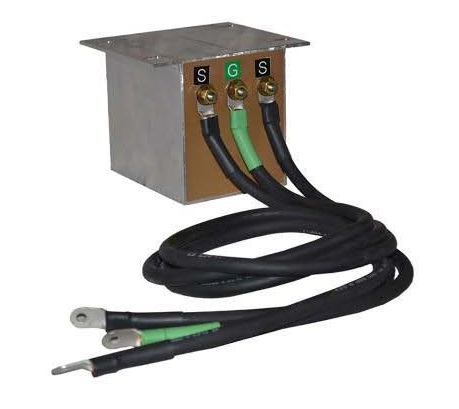
Projection Welding
Questions and Answers
In a wire mesh welder many welds are made at virtually the same time. The wire is in contact with the machine, fixtures and electrodes in many places. It is important that the current goes through the weld and not stray through the fixture or machine components. The most important step is machine design. It is imperative that all of the fixtures and support structure of the machine be electrically insulated and nonconductive. This is a machine design issue. The resistance of the wire will retard that flow but the goal is to have a designed path for the flow not a random path.

GROUND REACT0R
Secondly all machines should be properly grounded and or have the correct safety devices installed and functional. If a floating secondary is present a ground reactor will be employed for AC or a ground resistor for MFDC. The ground reactor is attached to both the positive and negative pads and is center tapped to ground. If the secondary voltage exceeds its reactors rating it immediately will flow all current to ground and trip the breaker. The ground resistor works in a similar fashion for the MFDC system except it only connects the negative pad to ground.
Proper electrical grounding is very important and should be performed by personnel familiar with the equipment and safety requirements necessary. Contact a machine builder, reputable distributor or facility engineer.
References: RWMA – Resistance Welding Manual 4th Edition
AWS – AWS J1.2 - Guide to the Installation and Maintenance of Resistance Welding Machines
Projection welding weld nuts is very common in industry. There is some data available on the subject. One source is AWS. The other is Ohio Nut and Bolt Company. Their site has schedules for many weld nuts and studs to choose from.
The answer to this question is maybe. It will depend upon several variables that were not supplied with this inquiry.
MATERIAL BEING WELDED – stainless steel, low carbon steel and aluminum have increasing current requirements.
MATERIAL THICKNESS – This will dictate the size of the projection. Projection size will dictate current amperage, time and force requirements.
PRODUCTION RATE – Number of welds per minute.
TYPE OF MACHINE/TRANSFORMER – Press welder, AC, DC, MFDC
With this information one can size the transformer needs and make an informed decision.
In projection, resistance brazing or spot welding, residue from the process eventually builds up on the face of the electrode.
CLEANING COPPER SPOT WELDING ELECTRODES:
In the case of spot welding mushrooming is also present. Spot welding electrodes are normally copper alloys making a machining process on or off the machine the most practical method of mushroom and residue removal.
CLEANING COPPER, COPPER TUNGSTEN (RWMA Class 11), MOLYBDENUM (RWMA CLASS 14) AND PURE TUNGSTEN (RWMA CLASS 13) PROJECTION & RESISTANCE BRAZING ELECTODES:
In projection welding and resistance brazing there can be some mechanical wear of the electrode face but frequently there is a buildup of fluze or foreign product generated from the weld, weld flash or???. At some point this buildup may interfere with part loading or locating. Cleaning becomes necessary. Depending upon the electrode material a simple machining process may be called for if it is a copper alloy.
In this scenario there are two possibilities:
1. The weld nut has come off.
2. The weld nut is still adhering the part.
In either case the weld nut projection geometry has been altered. The Question is what should be done to correct for this?
In Case # 1 the nut should be scrapped and new weld nuts welded to the part. This may require some refinishing of the weld blank at the weld location prior to rewelding. A clean smooth surface is desired prior to rewelding. Additionally, a process adjustment may be required to make an acceptable weld.
In Case # 2 this is a reprocess or repair. The only acceptable repair the Detroit-3 have ever considered is a form of arc weld to the exterior of the nut. This could be a MIG-braze if the metal is thin. If thicker a GMAW may be employed. A reweld would never be acceptable. There are too many variables to overcome to achieve an acceptable weld.
Page 5 of 14
Have a Question?
Do you have a question that is not covered in our knowledgebase? Do you have questions regarding the above article? Click here to ask the professor.
